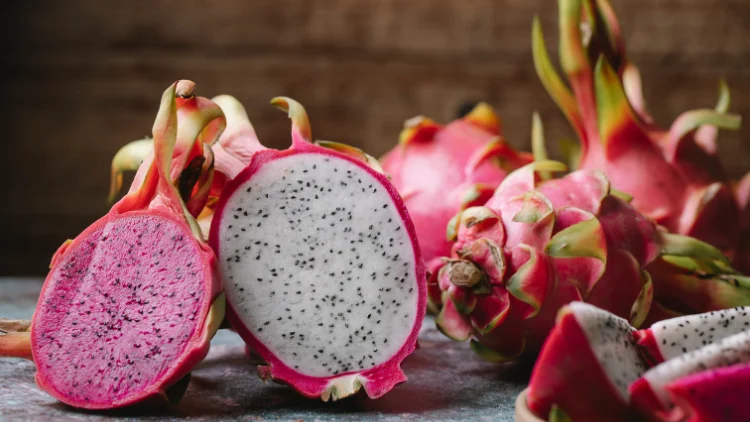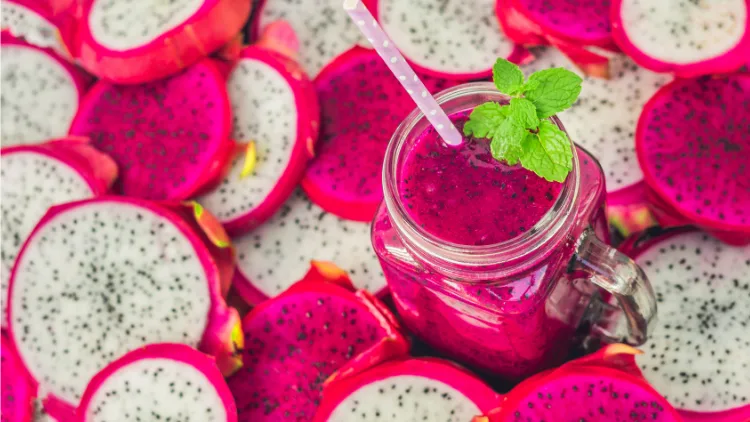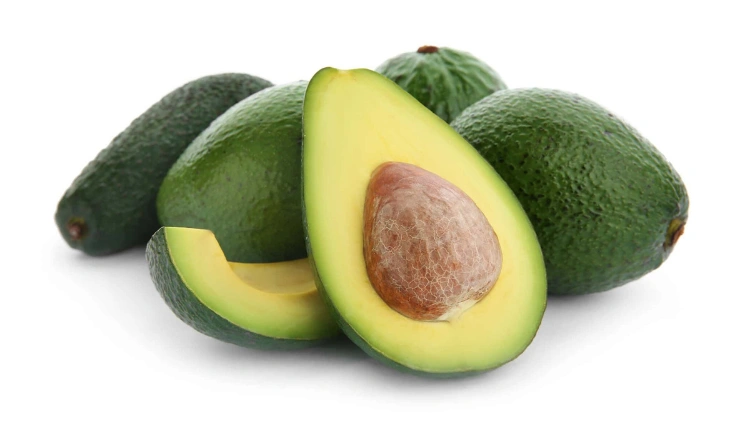
You might be curious about the dragon fruit keto-friendliness.1
Our high carb notice states that dragon fruit has a considerable amount of carbs due to the natural sugar and should only be consumed very, very small quantities on a keto diet.
For this reason, we’ll cover how many carbs is in each serving, how to make a tasty low-carb dragon fruit recipe, and 7 low-carb alternatives that are better for keto and have an array of health benefits too!
How Many Carbs Content in Dragon Fruit? Is Dragon Fruit High or Low in Carbs?
According to the U.S. Department of Agriculture, there are almost 13 grams of carbohydrates in 100 grams of dragon fruit.2 Dragon fruit also has 8 grams of sugar per 100-gram serving size.
For reference, a typical dragon fruit weighs between 300 and 650 grams so for the serving size of 100 grams that could be about ⅓ of the fruit.
In conclusion, dragon fruit contains a high amount of carbs and is best avoided on a keto diet, so the answer to whether dragon fruit is keto-friendly is no.
Amount of Carbs in Different Dragon Fruit Varieties
There are 4 different varieties of dragon fruit. The number of carbs in each variety is similar but does vary a bit due to certain varieties being sweeter, such as the red and pink dragon fruit.
- White Dragon Fruit: This dragon fruit has pink skin and white flesh. It is the most popular type of dragon fruit. The taste is comparable to a grape. White dragon fruit has 13 grams of carbohydrates for a 3.5-ounce serving size.
- Red Dragon Fruit: This variation has red flesh and red skin. This fruit is sweet and has also been known to stain hands. Red dragon fruit contains lycopene, which is a powerful antioxidant known for improving heart health.3 The texture is comparable to a kiwi. Red dragon fruit has 12.8 grams of carbohydrates per 3.5 ounces.
- Pink Dragon Fruit: Pink dragon fruit has red skin but has a soft to hot pink flesh. One unique attribute of this dragon fruit is it can easily adapt to different types of soil and climates. Pink dragon fruit is comparable to red dragon fruit and has 12.8 grams of carbs in 3.5 ounces.
- Yellow Dragon Fruit: Yellow dragon fruit is known to be the sweetest and most tasty variety. This fruit has yellow skin and white flesh. There are 15.4 grams of carbs in 3.5 ounces of yellow dragon fruit.
Is Dragon Fruit Keto Approved?
Unfortunately, dragon fruit would be best to avoid while on a keto diet. While there are a number of variations of the ketogenic diet for someone to achieve ketosis it is typically recommended to limit carbohydrate intake to under 50 grams per day, with some recommendations being as low as 20 grams per day.4
Macro breakdowns for a keto diet can look like 70-80% fat, 10-20% protein, and 5-10% carbohydrates.5 Based on that information, and knowing that 100 grams of dragon fruit contain 13 grams of carbohydrates and 8 grams of sugar, it’s clear that there are too many carbs and sugar in dragon fruit to be suitable for keto.
In addition to being mindful of carbohydrate and sugar content, the glycemic index of foods can be of value for a keto dieter because foods with a higher glycemic index impact blood sugar potentially knocking someone out of ketosis.6
Despite the high sugar and carb content, dragon fruit actually has a low glycemic index ranging between 48-51. Even though it has a lower glycemic index, it’s still important to enjoy this fruit in moderation or completely avoid it while on keto due to the high number of carbs and sugar.
Health Benefits of Dragon Fruit
While it would be best to avoid dragon fruit on keto, someone may still be curious about the potential health benefits dragon fruit has. Dragon fruit is a fruit that consistently shows up in research studies and has been shown to provide some impressive health benefits.

Source: Any Lane from Pexels7
- High Levels of Antioxidants: Dragon fruit has high antioxidant properties that are linked to a positive impact on stress-related and inflammation disorders.8
- Potential to Limit Disease Risk: Daily consumption of dragon fruit has been linked to potentially preventing and reducing the risk of high blood pressure, diabetes, improving gut health, and colon cancer.9
- Improve Heart Health: Research has shown that consumption of dragon fruit pulp helped control oxidative damage and aortic stiffness in diabetic rats.10 While further research is needed, this study does show the potential positive implications dragon fruit can have on heart health in diabetic patients and how it may be diabetic friendly.
- Reduce Cardiovascular Disease Risk: A randomized trial showed that dragon fruit consumption significantly improved blood flow in the arteries and reduced the pulse-wave velocity which is a predictor for cardiovascular risk.11 It is believed these results are due to the high levels of betalains found in dragon fruit.
- Delay Muscle Fatigue: Strenuous activity causes an increase in reactive oxygen species which can cause damage to cell function and result in fatigue. Research has shown that consuming red dragon fruit declined oxidative stress, repaired cell function, and delayed muscle fatigue.12
Low Carb Dragon Fruit Smoothie Recipe for Keto Dieters
While dragon fruit does have a high number of carbs, consuming a small amount in a smoothie may be a good idea for someone on a keto diet. This recipe offers someone the opportunity to reap the health benefits dragon fruit has to offer while also remaining low-carb and high-protein which is keto compliant.

Source: galitskaya via Canva.com13
The below ingredients are for 1 serving size.
Ingredients:
- ¼ small dragon fruit (25 grams) (Can use frozen or fresh)
- 1 scoop whey protein powder (Pro tip: Look for a low-carb or zero-carb keto-approved one. The brand KetoGenics has a zero-carb natural protein that would be a perfect option here)
- ½ cup coconut milk
- 2 tablespoons monk fruit (Someone may also wonder is dextrose keto and while it is best avoided there is a long list of keto approved sweeteners that can be added here as a substitute to monk fruit)
- 2 tablespoons plain greek yogurt
Instructions:
- Add all of the ingredients to a blender. Blend on high until all ingredients are well mixed. Pro tip: add a few pieces of ice to the blender for a cold smoothie, especially if using fresh dragon fruit.
- Enjoy immediately!
Below is the nutrition breakdown for 1 serving size of the keto dragon fruit smoothie. The above recipe makes 1 serving.
- Calories: 162
- Fat: 2.5 grams
- Sodium: 143 mg
- Total Carbohydrates: 5 grams
- Fiber: 0.7 grams
Net Carbohydrates: 4.3 grams - Sugar: 4.2 grams
Protein: 26.5 grams
It is important to consider that this recipe still has a higher number of carbs. The small amount of dragon fruit included in this smoothie has 2.3 grams of net carbohydrates, whereas the same amount of strawberries would only have 1.4 grams of net carbs.
So while dragon fruit could be enjoyed in small amounts on keto different fruits such as strawberries may be a better substitute to make the above smoothie better suited and keto friendly. Here are some other tropical smoothie keto options.
Keto Fruits To Consider That Are Lower Carb Than Dragon Fruit
When following a keto diet it’s important to keep sugar and carb consumption to a minimum. Since dragon fruit is best avoided while on keto, someone may wonder what are some alternative fruits that have a lower number of carbs and may also question is papaya keto.
Often times fruit is labeled as having high numbers of carbs and sugar so someone may make the assumption that the list of keto-approved fruits may be short, but surprisingly there are a good number of fruits that would be extremely beneficial to add to a keto meal plan.
Here are 7 different keto fruits that are low carb and some that even have high contents of fat, making all of these perfect additions to a keto diet. It is important to remember serving size is important as consuming more fruit could quickly jump someone’s carb amount for the day.

Source: WebTechExperts from Pixabay14
- Avocado: Not only do avocados have a fairly low number of net carbs at 3 grams per ½ cup, but they also have 22 grams of fat. And specifically have 19 grams of unsaturated fats.
High-fat quantities are important while on a keto diet and choosing foods high in unsaturated fats is recommended to promote heart health, making avocados a great choice.15 - Blackberries: These berries are a sweet, low-fat, and low-carb treat. With a serving size of ½ cup, there are only 3 net carbs.
Additionally, blackberries are very high in vitamins C and K and fiber. - Raspberries: Raspberries are a fantastic keto-friendly option. For 10 raspberries there are only 1.1 grams of net carbohydrates.
They also have high levels of potassium, and have been shown to reduce blood pressure, and improve heart health.16 - Watermelon: For ¼ cup of diced watermelon there are only 3 grams of carbs and 2 grams of sugar. Watermelon is a fantastic option to add to a keto diet because of how hydrating it is.
Foods with high water content, like watermelon, may also be beneficial in weight loss because they may make someone feel full for longer.17 Because of this, consuming watermelon may be added to the list of potential weight loss solutions. - Tomatoes: A cup of cherry tomatoes contains 4 net carbs. They are full of vitamins C, E, and A.
Tomatoes also have high levels of lycopene, which has been shown to possess anticancer, antioxidant, anti-inflammatory, and antidiabetic potential, in addition, to protecting against heart, liver, bone, skin, and reproductive systems disease.18 - Rhubarb: While this fruit may be harder to find fresh outside of its growing season, rhubarb is bursting with vitamins and is low-carb at only 4 net carbs per 1 cup of diced rhubarb. This fruit does have a very tart flavor so while someone could enjoy it raw and on its own, it may be best enjoyed in small quantities in a smoothie.
- Strawberries: Half a cup of sliced strawberries have 4 grams of net carbs, which again makes these a fruit that could easily fit into a keto diet plan. Strawberries also contain low sugar levels and have even been shown to improve knee pain and inflammation in those with knee osteoarthritis.19
Dragon fruit has an impressive list of health benefits. While a lot of different foods could be enjoyed in moderation while following keto, there are better alternative options than dragon fruit.
Unfortunately, due to the high number of carbs and sugar dragon fruit keto is best avoided while following a keto diet.
Frequently Asked Questions
Is Dragon Fruit Mango From Starbucks Keto?
The dragon fruit mango refresher from Starbucks is best to be avoided while on keto, but here is some other keto low-carb Starbucks drinks. For a tall drink, the smallest option which is 12 ounces, there are 18 grams of carbohydrates and 15 grams of sugar which is way too much for a keto diet.
In conclusion, the question of whether dragon fruit mango keto is unfortunately a no.
Which Dragon Fruit Variety Has the Lowest Amount of Carbohydrates?
Most colors and variety of dragon fruit have a similar amount of carbs ranging from 11-13 for a 3.5 oz serving but pink and red dragon fruit have only 12.8 grams per 3.5 oz. On the contrary, yellow dragon fruit has slight more carbs, coming in at 15.4 per 3.5 oz serving.
References
1Lan Anh Hoang. Canva. Accessed 22 April 2023. <https://www.canva.com/photos/MAE9ljXaSd0-woman-in-floral-dress-holding-a-dragon-fruit/>
2U.S. Department of Agriculture. (2023). Dragon Fruit Bite-Size Fruit Cubes. FoodData Central. <https://fdc.nal.usda.gov/fdc-app.html#/food-details/537279/nutrients>
3Bacanli, M., Basaran, N., & Basaran, A. A. (2017). Lycopene: Is it Beneficial to Human Health as an Antioxidant? Turk J Pharm Sci, 14(3), 311-318. <https://www.ncbi.nlm.nih.gov/pmc/articles/PMC7227929/>
4Masood, W., Annamaraju, P., & Uppaluri, K. R. (2022). Ketogenic Diet. StatPearls [Internet]. <https://www.ncbi.nlm.nih.gov/books/NBK499830/>
5Harvard T.H Chan School of Public Health. (2023). Diet Review: Ketogenic Diet for Weight Loss. The Nutrition Source. <https://www.hsph.harvard.edu/nutritionsource/healthy-weight/diet-reviews/ketogenic-diet/>
6Esfahani, A., Wong, J. M. W., Mirrahimi, A., Srichaikul, K., Jenkins, D. J. A., & Kendall, C. W. C. (2009). The glycemic index: physiological significance. J Am Coll Nutr. <https://pubmed.ncbi.nlm.nih.gov/20234030/>
7Any Lane. “Halved dragon fruit on table.” Canva. Accessed 8 April 2023. <https://www.canva.com/photos/MAEOH3DMUrg-close-up-photo-of-sliced-dragon-fruit/>
8Pasko, P., Galanty, A., Zagrodzki, P., Luksirikul, P., Barasch, D., Nemirosvki, A., & Gorinstein, S. (2021). Dragon Fruits as a Reservoir of Natural Polyphenolics with Chemopreventive Properties. Molecules, 26(8). <https://www.ncbi.nlm.nih.gov/pmc/articles/PMC8070077/>
9Joshi, M., & Prabhakar, B. (2020). Phytoconstituents and pharmaco-therapeutic benefits of pitaya: A wonder fruit. J Food Biochem, 44(7). <https://pubmed.ncbi.nlm.nih.gov/32378233/>
10Anand Swarup, K. R. L., Sattar, M. A., Abdullah, N. A., Abdulla, M. H., Salman, I. M., Rathore, H. A., & Johns, E. J. (2010). Effect of dragon fruit extract on oxidative stress and aortic stiffness in streptozotocin-induced diabetes in rats. Pharmacognosy Res, 2(1), 31-35. <https://www.ncbi.nlm.nih.gov/pmc/articles/PMC3140125/>
11Cheok, A., Xu, Y., Zhang, Z., Caton, P. W., & Rodrigues-Mateos, A. (2022). Betalain-rich dragon fruit (pitaya) consumption improves vascular function in men and women: a double-blind, randomized controlled crossover trial. Am J Clin Nutr., 115(5), 1418-1431. <https://pubmed.ncbi.nlm.nih.gov/35265960/>
12Rusip, G., Ilyas, S., Lister, I. N. E., Ginting, C. N., & Mukti, I. (2021). The effect of ingestion of red dragon fruit extract on levels of malondialdehyde and superoxide dismutase after strenuous exercise in rats ( Rattus norvegicus). F1000Res. <https://www.ncbi.nlm.nih.gov/pmc/articles/PMC9345267/>
13galitskaya. “Dragon Fruit Smoothie with Fruit Slices.” Canva, Accessed 8 April 2023. <https://www.canva.com/photos/MAEJDjystyU-dragon-fruit-smoothie-with-fruit-slices/>
14WebTechExperts. Canva. Accessed 8 April 2023. <https://www.canva.com/photos/MAEPjs2kyMs/>
15Hayes, J., & Benson, G. (2016). What the Latest Evidence Tells Us About Fat and Cardiovascular Health. Diabetes Spectr., 29(3), 171-175. <https://www.ncbi.nlm.nih.gov/pmc/articles/PMC5001225/>
16Burton-Freeman, B. M., Sandhu, A. K., & Edirisinghe, I. (2016). Red Raspberries and Their Bioactive Polyphenols: Cardiometabolic and Neuronal Health Links. Adv Nutr, 7(1), 44-65. <https://www.ncbi.nlm.nih.gov/pmc/articles/PMC4717884/>
17Buckland, N. J., Camidge, D., Croden, F., Lavin, J. H., Stubbs, R. J., Hetherington, M. M., Blundell, J. E., & Finlayson, G. (2018). A Low Energy–Dense Diet in the Context of a Weight-Management Program Affects Appetite Control in Overweight and Obese Women. J Nutr, 148(5), 798-806. <https://www.ncbi.nlm.nih.gov/pmc/articles/PMC6054218/>
18Imran, M., Ghorat, F., Ui-haq, I., Aslam, F., Heydari, M., Shariati, M. A., Okuskhanova, E., Yessimbekov, Z., Tiruvengadam, M., Hashempur, M. H., & Rebezov, M. (2020). Lycopene as a Natural Antioxidant Used to Prevent Human Health Disorders. Antioxidants (Basel), 9(8), 706. <https://www.ncbi.nlm.nih.gov/pmc/articles/PMC7464847/>
19Schell, J., Scofield, R. H., Barrett, J. R., Kurien, B. T., Betts, N., Lyons, T. J., Zhao, Y. D., & Basu, A. (2017). Strawberries Improve Pain and Inflammation in Obese Adults with Radiographic Evidence of Knee Osteoarthritis. Nutrients, 9(9). <https://pubmed.ncbi.nlm.nih.gov/28846633/>